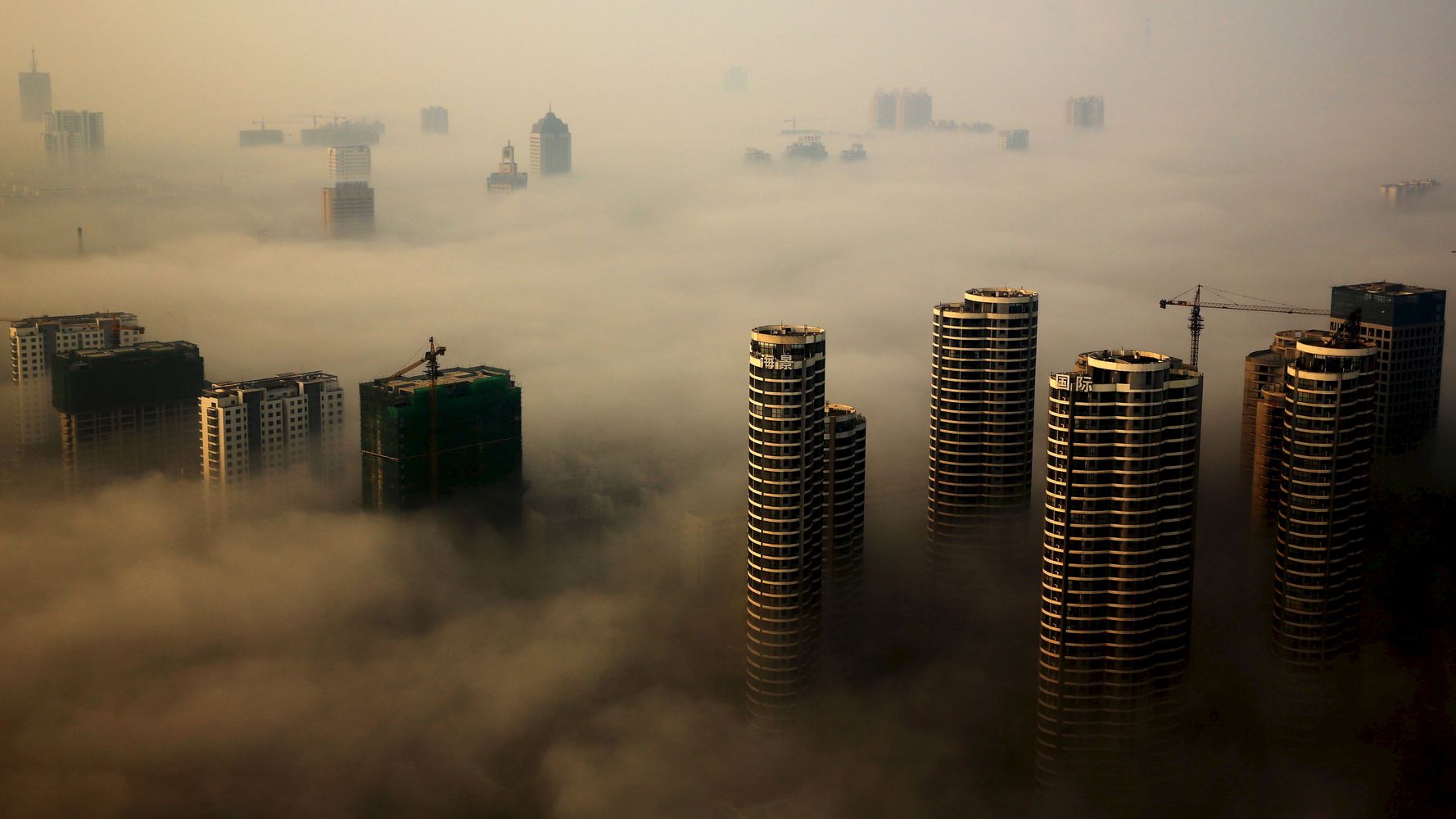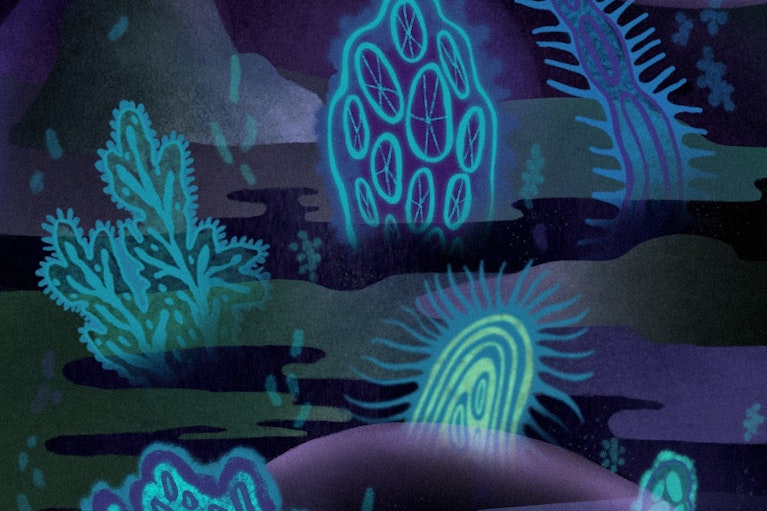RIZHAO, China ― Facing South Korea across the Yellow Sea and beyond that peninsula, Japan, this resort town takes its name from an old poem — ri chu xian zhao, or “first to get sunshine.” These days, three million citizens enjoy that early sunshine, along with the beach, sea breeze and a swelling array of amenities, including modern apartments outfitted with televisions and hot water.
The men and women who govern Rizhao have another hope for the small city: to make it one of the first in China and the world to spew no more greenhouse gases than the city can get rid of through technology fixes and planting trees. Much of the city’s greenhouse gas currently comes from coal burning and cars.
“The city will try to go carbon neutral,” says Fan Changwei, a middle-aged lawyer who has worked his way up the leadership ladder at the local environmental protection bureau and who has helped lead this seemingly quixotic effort. He resembles one of the tall, thin smokestacks on the local coal-fired power plant, only he burns through as many cigarettes, rather than coal, as time permits. Taking a deep drag and exhaling, he adds, “I don’t know when we will succeed, but we will move in that way.”
Rizhao is just one of a handful of places globally — Copenhagen in Denmark, Arendal in Norway, Melbourne in Australia and the entire country of Costa Rica, to name a few — that even attempt to balance their daily exhaust of carbon dioxide, the same greenhouse gas breathed out by Fan amid all that cigarette smoke. The local Communist cadres who run this city believe that leading a transition to a cleaner economy will help drive economic growth and their careers.
Rizhao is growing, like most cities in China, building skyscraper after skyscraper and apartment block after apartment block amid the long, low buildings that make up its older homes and businesses. The local mayor went on to become vice governor of the entire province of Shandong due to his success in creating what is known as a “circular economy,” which could be China’s answer to the challenge of climate change and perhaps a way to build an enduring Anthropocene.
“To save money is very important,” Fan notes, as an explanation of sorts.
The circular economy is a simple idea but hard in practice: no waste. The residue of one process ― say, making citric acid for soda at the Jinma Industrial Park ― turns into the feedstock of another.
The grainy smell of sour mash wafts throughout the park, and a whirring roar fills the air. The key component is a special “biodigester” from Holland, essentially an industrial stomach for turning corn and sweet potatoes into citric acid, stinky water and residual grains. The wastewater pools exude methane, most to be captured as what the Chinese engineers call marsh gas.
This industrial stomach makes 25,000 cubic meters of marsh gas per day, and there are 10 similar enterprises throughout the small city. The marsh gas gets burned to run six generators pumping out electricity. The residual heat from that process is used to warm local buildings. As for the leftover bits of corn, sweet potato and cassava, that becomes feed for the animals.
Encouraged by government subsidies that cover at least half the cost of installation, more than 80 such biodigesters in the villages around Rizhao help households that are fueled by pig or fox dung. Some of the marsh gas is burned in the ubiquitous greenhouses that grow vegetables, both to keep the temperature warm and to kill off pests. In the future, the hope is to make so much of this marsh gas that it can even be used as a fuel for the vehicles multiplying on Rizhao’s streets.
“The technology of compressed marsh gas is not too difficult,” Fan says. But it is very expensive. A more efficient stove alone will set a peasant back at least 1,500 yuan (about $230), a significant portion of a peasant family’s annual income.
The circular economy is an old idea in China, as old as the human dung gatherers who sold night soil from the cities to the farmers as fertilizer for the fields. “Organic fertilizer is much better than chemical fertilizer,” Fan notes, adding that it is used to grow the region’s “famous” tea, some of the northernmost tea grown in China.
The circular economy is a synonym for thrift ― an old-fashioned value everywhere in the world. After all, the poor don’t produce much trash, as anyone who lived through the Great Depression can attest. “Economics are important,” as Fan puts it. In this sense, aluminum cans may be the ultimate object of the circular economy: endlessly recyclable with no diminution in quality and saving much of the mega-energy required to create aluminum from bauxite ore. Everything else is a bit more complicated.
People like Fan drive Rizhao toward being carbon neutral through a mix of using less energy to produce more, recycling the wasted energy of one process to drive another and getting energy from cleaner resources — like replacing coal with solar, wind, marsh gas, even nuclear. The small city’s economy is built around the cargo port and manufacturing: electronics and electrical systems for cars, furniture, paper, textiles and food processing.
Fan’s workday consists of enforcing the law ― issuing fines for companies that pollute too much and sometimes even shutting them down. But it is all within reason because helping peasants deliver themselves from poverty via the city remains China’s overall strategy: political stability through economic growth.
As the joke goes, the pollution haze is a deliberate plot to hide China from the spying eyes of American satellites.
On a recent visit to Rizhao, Fan and I drive from the Qingdao airport to the city on a highway lined with newly planted poplar trees. “Trees are also good for carbon neutral,” Fan observes, smiling. Government officials had to learn the hard way that planting all the same trees left them vulnerable to death by a single pest. Now the government plants a variety, albeit still in the same rigid lines easily distinguishable from the random scattering of a more natural forest.
Earth movers and mechanical shovels have dug into the hillsides here in the quest for ever more material for concrete to make smooth roads or concrete foundations elsewhere. Geologic features seem to be collapsing in on themselves, and there are no trees on those distant hills. Erosion is everywhere.
The local crops are mostly wheat and peanuts, Fan says. Everything is cultivated in tiny, human-size rectangular plots. It is the amount of land a single peasant family can work and the hallmark of this deeply worked-over landscape. Lonely smokestacks poke up out of the fields where peasant kilns churn out bricks. In all the kilometers between the airport and Rizhao, there is not one centimeter of land unmarked by human hands, except perhaps some of the stone outcroppings on the mountains.
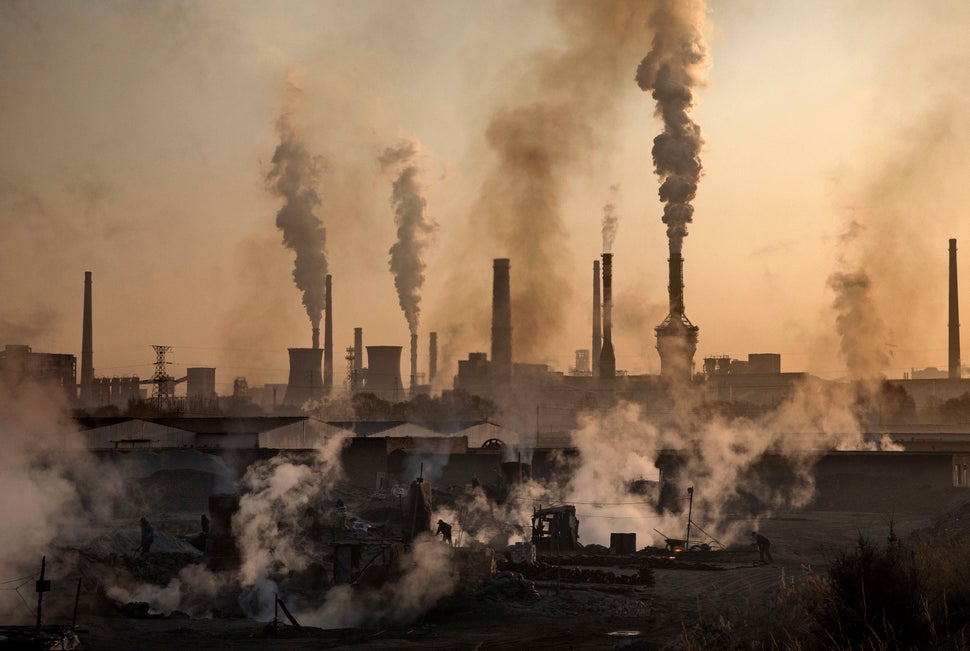 Smoke billows from a large steel plant at an unauthorized factory in Inner Mongolia, China. Nov. 4, 2016.
Smoke billows from a large steel plant at an unauthorized factory in Inner Mongolia, China. Nov. 4, 2016.China has become an enthusiastic participant in globalization, kicked off by the British Empire and brought to its current state of interconnectedness by the United States. The road signs on these gleaming new highways are in both Chinese characters and the Roman alphabet that spells out English words. Globalization makes China’s air pollution — whether the carbon dioxide that invisibly warms the globe or the tiny particles of soot that smear the sky — some of the worst in the world. On certain days, the air in Beijing has approached 500 points on the air quality index. In the U.S., even a forest fire combined with smog from cars and haze from power plants rarely sends levels as high as 300. This is the world-famous “airpocalypse.”
Athwart that pollution apocalypse stands Fan. For years before carbon neutrality became the hip new thing in Rizhao, the goal was to tamp down on dust and sulfur dioxide and eliminate water pollution. Fan and his colleagues have so far failed to do much of that. “It is not easy,” Fan says of environmental protection in general in a land trying to grow as fast as possible as an economic giant and a global superpower. “We will try. And manage to do … something.”
 A laborer uses a machine to stir crushed peanuts at a workshop in Rizhao. Dec. 11, 2010.
A laborer uses a machine to stir crushed peanuts at a workshop in Rizhao. Dec. 11, 2010.Modern Beijing is burning, its sky choked with smoke that turns the afternoon into dusk. The tang of combustion even filters into the airport terminal, which is shaped like a mythical dragon ― no doubt a fire-breather. The sweet smell of diesel and gasoline in the parking garage comes as a relief.
The tang from all that pollution may be the taste of development, and the peach haze of a morning the look of progress. This is the price of an economic project that has enabled hundreds of millions of peasants to lift themselves out of lifetimes of poverty. In 1981, the majority of people in China lived on less than $1.25 a day. By 2008, some 660 million Chinese — or two times as many people as live in the entire U.S. — had worked their way out of such extreme poverty, helped by a nominally Communist government and their own pluck.
My flight from the U.S. to China was much more than a crossing of the international date line. I traveled more than a half-century into the past, when a killer smog killed 20 people in Donora, Pennsylvania, and the skies of Pittsburgh were dark at noon. If there is another way to grow rich, China has not found it. China is currently living in the future past, a Dickensian steampunk sci-fi drama in Mandarin, complete with high heels and disfigured orphans.
Life goes on in Beijing under this empire, like the others before it ― taxi drivers gamble and laugh over cards, old people murmur as they shuffle mah-jongg tiles. Kids play in the streets, and in the ancient alleyways known as hutongs, gangs of small boys already smoke cigarettes. The difference is the power lines leading into the hutongs and the brilliantly painted majestic doors, even if weeds poke up here and there among the roof tiles of the rapidly gentrifying area.
China is living in the future past, a Dickensian steampunk sci-fi drama in Mandarin, complete with high heels and disfigured orphans.
There are ambitious but unsustained attempts to build an eco-city in China ― in Huangbaiyu, Dongtan and Tianjin. Perhaps first among these was Dongtan, or “East Beach,” on the alluvial island of Chongming, across the mouth of the Yangtze from Shanghai’s Pudong district. And although a bridge and a tunnel connect Chongming to Shanghai, no city yet troubles the marshes there, which is good for the birds that use them as one of the few remaining landing spaces in all of China.
This city-in-a-marsh promised to produce little trash thanks to its circular economy, rely on the plentiful sea breezes for power and permit only those vehicles that spew no CO2 from their tailpipes, such as hydrogen or electric cars. Hundreds of pages of plans, maps, charts and even a glossy coffee table book laid out, in great detail, the inner workings of this ecotopia: energy-efficient buildings clustered close together to promote walking among the 50 residents per acre, organic farms arrayed around the new development for food and a power plant fueled by rice husks that would also heat homes. Even the birds would find a comfortable home among the canals and ponds that brought the surrounding wetlands into the city’s design itself.
Meant to be completed by 2010 when Shanghai hosted the World Expo, Dongtan instead remains a dream and a marsh, done in perhaps by the corruption arrests of its local government and developer champions or perhaps by the impracticality of its fantasies. Dongtan is a Potemkin village that never even got built.
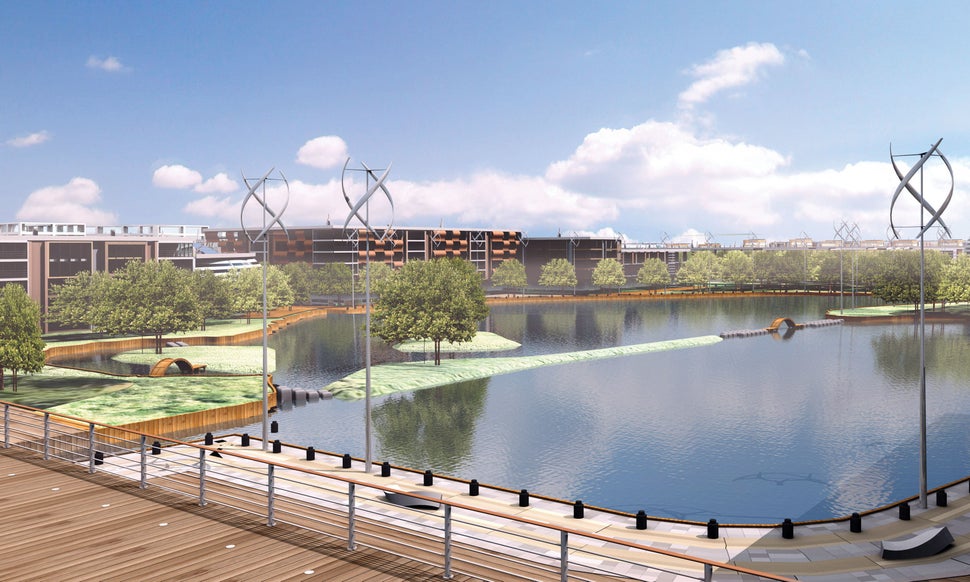 An artist’s rendering of Dongtan, China’s unbuilt eco-city, showing micro windmills and low-lying buildings that use special thermal technology to save energy.
An artist’s rendering of Dongtan, China’s unbuilt eco-city, showing micro windmills and low-lying buildings that use special thermal technology to save energy.Rizhao is also an ecological civilization trial site. The seaside city with its enclosed marina is essentially a tourist community. Last year, 27 million Chinese, primarily from inland provinces, visited to see the sea. But no one is accounting for all the carbon dioxide the tourists from Anhui, Henan, Hubei and Shaanxi emitted getting to Rizhao.
Still, all those tourists mean the example of Rizhao could spread. Perhaps the Anthropocene should be renamed in Mandarin, or Sanskrit. The developing man’s burden will be nothing less than saving the world.
In 2004, the city that is “first to get sunshine” used said sunshine to heat water. The Shan Shui hotel (Mountain Water) installed solar hot-water heaters from Tsinghua University on its roof. Glass tubes with black carbon inside absorbed the sun’s heat and transferred it to the water.
Now such solar hot-water heaters are the law, and regiments of them line the rooftops of every new building. Natural gas is cheap but sunshine is free, even if the systems cost at least 4,000 yuan (nearly $600). Plus, Rizhao gets a fair share of it ― 260 days of sunshine, according to Fan and the local weather bureau. “This is why we install solar energy,” he explains. Still, on the day of my visit to Mountain Water hotel, it is raining in the sunshine city.
Sunshine to electricity might be key to a world that burns less coal. China is the home of much of the world’s photovoltaic production. More than 500 companies compete to churn out solar technology, and the country has already seen the rise and fall of at least one Sun King.
Even as solar gets cheaper, however, it is still too expensive for most Chinese. “If you want to generate solar energy, the costs are very high,” Fan explains. “But in the future we can use this technology.” That future can be seen on some of Rizhao’s lampposts, which use solar energy to light up the beachside at night.
Rizhao also now has over a million solar hot-water heaters, which line the rooftops of new buildings. Glass tubes with black carbon inside absorbed the sun’s heat and transferred it to the water. Luckily, Rizhao gets a fair share of sunshine: 260 days of sunshine, according to Fan and the local weather bureau.
The developing man’s burden will be nothing less than saving the world.
Like the imaginary Dongtan and all-too-real pollution of Tianjin, Rizhao has a plan: the ecological city construction plan authored by members of the Chinese Academy of Science and Technology for Development. It is not just clean energy or the circular economy. A World Bank loan enabled the city to build a world-class sewage treatment facility, with chlorination and reverse osmosis intended to make the water discharged into the sea clean or at least cleaner.
Rizhao is torn between tourism and industry, especially the port. The most polluting industries have moved from the city to the surrounding countryside. They impinge on the villages but allow Rizhao to inch closer to carbon neutral. In any larger scheme, however, there is no “away” to throw away to; the pollution that spews from factories on the outskirts of town will eventually impact the city. In some sense, climate change is the new front in a war between local governments focused on growing local economies and the central government focused on preserving social stability at any cost.
Fan is not like other officials, according to Frank, an affable young man who accompanies me on my second visit to Rizhao. Frank is his adopted English name, which he chose because he wants to be frank. Twenty-eight years old, he shelters his broad face under a baseball cap. He has a big, easy laugh that reveals the white teeth that brand him as a nonsmoker, a relative rarity among Chinese men. He complains of being too fat.
Trained in science, Frank now works on history and literature at a small press, simply because there are too few jobs for physicists. He is an ardent believer in free markets and Austrian economics as well as being a Communist Party member, voicing near constant criticism of his own party. Such is modern China. “If you think you have big government in the U.S., come here,” Frank says.
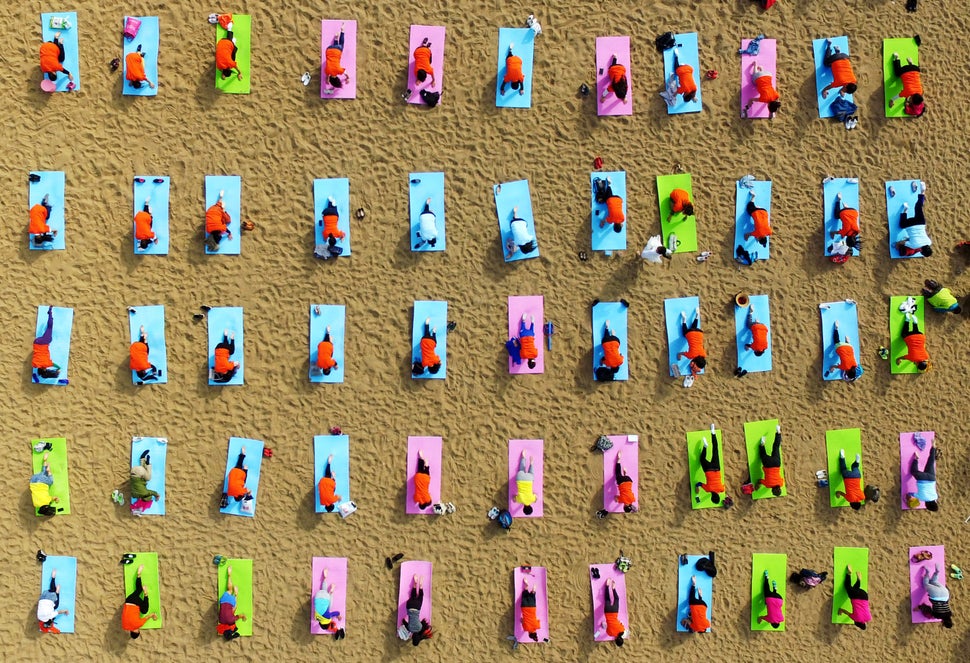 Yoga on the beach in Rizhao. Oct. 6, 2016.
Yoga on the beach in Rizhao. Oct. 6, 2016.The newest part of Rizhao is a former lagoon that now hosts luxury hotels, a marina and a venue for the local bourgeoisie’s weddings. In only four years in the early 2000s, Rizhao filled in nine square kilometers of lagoon, reshaped it and built on it. That’s more than one-quarter of Rizhao’s entire sprawling extent.
That is far from the only beneficial reuse of waste in this would-be circular economy. The fly ash left over after the coal is burned in the local power plant becomes brick, cement and even cinder blocks, used for the continuous apartment construction. Waste even becomes energy, burned directly in Honolulu, for instance, where landfill space and fuels are both at a premium.
Yet still there is more waste ― on the land, in the water, in the air. Air pollution — dust and soot — rises off the North China Plain like steam from a lake in winter. The Great Pall of China completely obscures the country, turning the sky a dull yellow or blue blur, depending on the type of pollution. As the joke goes: The haze is a deliberate plot to hide China from the spying eyes of American satellites. Too bad it cuts short the lives of the Chinese themselves and travels all the way across the Pacific Ocean to the U.S., the same path as the tidal wave of imports whose manufacture partially created it.
Some of that haze is pollution from the thousands of coal-fired power plants and millions of cars that China has added in the last few decades of unparalleled economic growth. But some of it is older: dust blown off the Gobi and Taklamakan Deserts, great arid swaths advancing on cities like Beijing and held back only by one of the largest geoengineering projects on the planet, the Three-North Shelterbelt Forest Program. In 1978, China began planting trees to hold back the desert; the goal is 100 billion trees serving as a Great Green Wall across a 4,500-kilometer belt of northern China. Its efficacy remains in dispute, but no one can dispute that the Chinese, when they do something, do it big.
Heedless growth leaves a long-lasting mark.
To diminish the mountain of coal burned every day to power China, the country is planning other huge engineering projects: a hundred or more nuclear reactors and the largest wind farms and dam in the world. The apparatchiks who run China were often trained as engineers, so engineering solutions seem to appeal to them. In some ways, it is reminiscent of 1950s America and the can-do optimism of scientism ― the idea that science can be applied to solve social problems.
China is being run by the same triad of military, industry and science professionals of progress who ran the U.S. in the halcyon days of “I like Ike.” Xi Jinping trained in chemical engineering, Hu Jintao in hydroengineering, Wen Jiabao in earth moving. Scientism run amok also provided the dams that litter the western U.S. ― not all of them necessary, a mistake China is currently repeating as local governments rush to secure the jobs and money available for such projects.
All these nuclear power plants, wind farms and dams are the only hope China has to keep its promise to stop using the atmosphere as an open sewer. That may prove a faint hope. As Frank says of the massive build-out of nuclear power plants, “Anything built in China cannot be safe. Too much corruption.”
That goes for the dams too and the wind turbines often spinning to no purpose. At Daya Bay in the south, China’s first nuclear reactor, a viewing platform shows where the steel bars necessary to reinforce the containment vessel were left out, forcing a rethink and modifications to buttress the reactor vessel in some other way. The concrete pier stands as a testimony to transparency perhaps but also to the kind of corruption that allows a construction firm to undercount the number of steel rods required or to claim so in a time and moneysaving step. The very first reactor the Chinese ever built, at Qinshan in Zhejiang Province, had to be torn down and rebuilt because of flaws in the foundation and defects in the welding. And the former head of the China National Nuclear Corporation has been sentenced to life in prison for corruption.
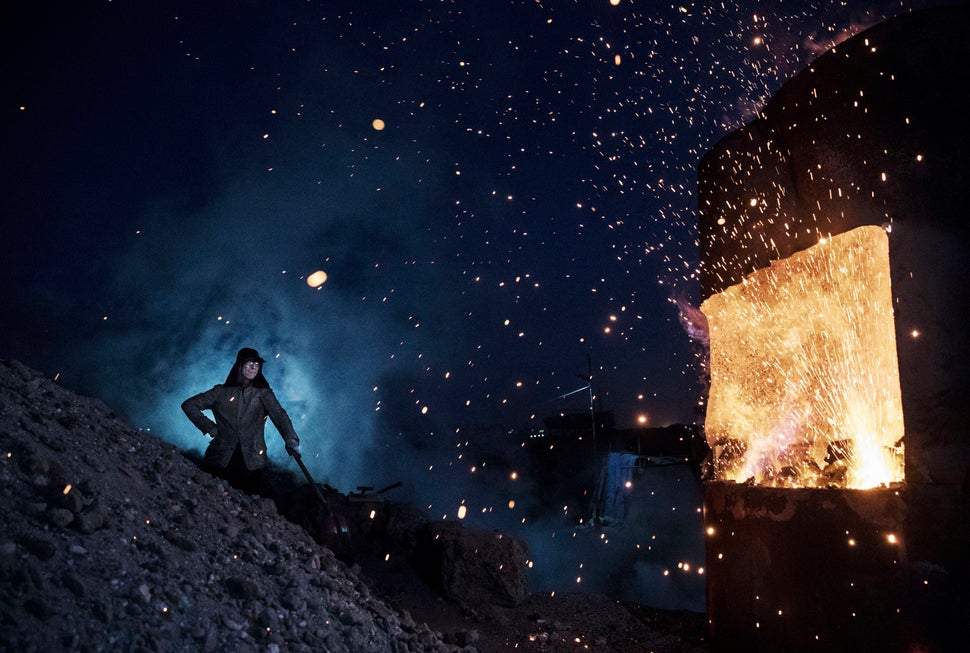 A Chinese laborer stands near a furnace at an unauthorized steel factory on Nov. 3, 2016 in Inner Mongolia, China.
A Chinese laborer stands near a furnace at an unauthorized steel factory on Nov. 3, 2016 in Inner Mongolia, China.Heedless growth leaves a long-lasting mark. China is repeating the coal-to-gas mistake, setting up conversion facilities and power plants that convert coal to natural gas, given that the country has lots of coal and wants natural gas in order to cut down on all that choking smog and soot. In addition to a problematic tarry residue, turning coal to gas has the downside of increased carbon dioxide emissions, even worse than just burning the coal directly. This is not the only repeated mistake.
China’s chemical industry turns rivers all the colors of the rainbow, and a flotilla of dead pigs is not an uncommon sight in the waterways. The rivers run black sometimes thanks to such effluents, says Ma Jun, one of China’s preeminent environmentalists. Most such polluting goes unpunished, and those who do draw the ire of the local, provincial or central government pay fines that are a small fraction of the profits gained from the pollution. “It is increasingly difficult to find clean water,” Ma told me.
Some 300 million people — nearly the entire population of the U.S. — still have no access to clean water, and two-thirds of China’s booming cities do not have enough water of any kind, a condition the government calls “water-stressed.” Rivers are dry mudflats with smaller rivulets carving a path through the muck or pooling in fetid dead ends. The central government is building a massive viaduct to siphon water from the Yangtze River and bring it north to Beijing and beyond, a megaproject called the South-North Water Diversion, which forced 300,000 people to move out of the way. Meanwhile, waterless urinals thank patrons in English for protecting water, which is “a scarce resource on Earth.”
No one can dispute that the Chinese, when they do something, they do it big.
Still, some lessons have been learned. Shanghai Chemical Industry Park is building a swamp to deal with its wastewater, cleansing chemical contamination in a habitat built for marsh life ― like frogs, not people.
I sit for hours in Shanghai traffic to reach this small fake wetland on the outskirts of town. Trees are everywhere. There is toad song, there is birdsong. Dragonflies perch on the edge of marsh grasses as towering wind turbines spin slowly in the distance. Crabs scuttle beneath the wooden bridges, and tadpoles join fish for a swim in multiple ponds. The polluted water flows in at a rate of 22,000 cubic meters per day, spends a week meandering through the 30-hectare artificial swamp, making the algae bloom, and comes out cleansed, prevented from seeping into the ground by a plastic liner that pokes up here and there like a partially buried garbage bag.
On one side of this water park is a village, and village life creeps in too, like the guy cutting through the swamp’s wooden paths on his bike and local farmers hoeing just over the wall. As everywhere else in China, there is a farm on any available piece of relatively flat land, which includes terraced mountainsides from Liaoning to Yunnan. Styrofoam, plastic wrappers and discarded cans of Suntory beer litter the verdant pools of this custom-built swamp. On the other side is the China Petrochemical Research Institute, which contributes much of the fouled water. The rest comes from the litany of chemical companies in the area: Air Liquide, BASF, Bayer, CITIC, DuPont, Fluor, Hagemeyer, Huayi, Mitsui, Sinopec, 3M. The problem is not a lack of technology or a lack of money; it is a lack of motivation, not unlike the world’s lack of will to combat climate change.
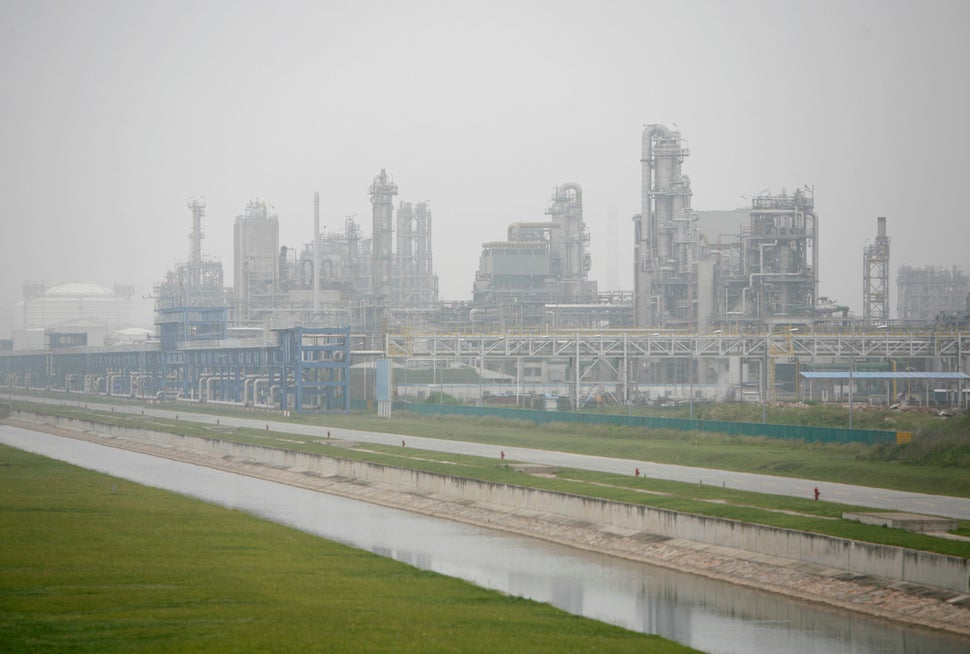 Water runs past a petrochemical plant at the Shanghai Chemical Industry Park. May 29, 2007.
Water runs past a petrochemical plant at the Shanghai Chemical Industry Park. May 29, 2007.On a bus trip back to Rizhao with Frank, we pass Mount Tai, one of the most sacred mountains in all of China. Smog renders it nearly invisible, even though this is technically a “blue sky day” for the area around Jinan. Tiny peasant plots cover the countryside, interspersed with the occasional village, some with the fancy doors on homes that denote new wealth, and some still poor. Frank’s duties for the Communist Party include working in one such poor village, which would really like a sewer system, for which Frank has no funds. Without funds, poverty alleviation is all window dressing.
On arrival, Frank and I share a taxi from Rizhao’s bus depot to our hotel that runs on a tank of compressed natural gas so big there almost isn’t enough room for luggage. Fueling up requires driving past a line of waiting cars and backing into a refueling station trunk first. On a per-kilometer basis, natural gas is cheaper than oil in China, even though the gas comes all the way from central Asia or Russia. The U.S. may talk about an all-of-the-above strategy on energy, but the Chinese really live it.
Everywhere there are more and more cars, growing by 20 or even 30 percent per year in some cities, including Rizhao, precluding any hoped-for carbon neutrality or even smog reduction. Frank thinks carbon neutral might be possible in some wealthy Scandinavian country like Denmark. But not in China. There is simply too much growing to do.
I meet Fan at a seafood restaurant. In some ways, he seems even younger than a few years earlier, with his buzzed hair and skinny physique. The smoking helps keep him thin, perhaps, now that he no longer bikes to work. He claims to have gained 5 kilograms, but I cannot see it. While we eat, the ubiquitous television broadcasts the doings of Xi Jinping and the central government, as they war on corruption, unrest and pollution.
The problem is not a lack of technology or a lack of money; it is a lack of motivation.
Fan is now working on “total pollution control,” though that totality apparently does not include carbon dioxide. He admits that there is no way even to restrain any kind of pollution during the present era of growth and industrialization. Maybe someday, he says, exhaling a cloud of smoke from yet another cigarette. But not now.
So many cleanup efforts have fallen by the wayside in China over the early years of the 21st century: green gross domestic product, green growth and now, perhaps, carbon neutral. These days the talk is of how growth will be sacrificed for “clean development,” but there are few signs of clean air and plenty of new coal-fired power plants, port expansions, construction cranes and goods from cars to solar panels churned out by mass-production lines.
Just as Frank cannot get the money for sewers in his village, Fan cannot get the money for pollution-control technology. Factories cannot afford to install their own pollution controls and, as everywhere, environmental protection is resisted or, as Fan puts it, not all the owners are cooperative. They want to “play sneaky,” he says, though emissions-monitoring technology and new rules including fines may help with that. And factories are much easier to handle than, say, the volatile organic compounds released at the city’s growing number of gas stations.
The next day dawns peach and clear over the East Sea. Fan comes to visit Frank and me at our hotel for another friendly chat. Fan touches his ear as he tries to remember the past or some arcana from his pollution control battles. He leans back in his chair and remembers a time when the tallest building in town was only five stories. Now several reach 40 stories or more thanks to investors from other provinces. My taxi driver thinks all the new construction is just a hiding place for ill-gotten gains from mining. Miners get cancer while owners get rich. The coal afflicts everyone from village families that lose fathers to Beijing residents breathing fouled air that cuts short their lives.
Villagers from the surrounding countryside are ushered into Rizhao, now swollen to 3 million people. And yet tall apartment buildings prevent the intensive use of solar hot-water heaters, because the available roof area is just too small for all those apartments. People leave for work before the sun has even risen, too early for the solar heaters to have warmed up their bathwater.
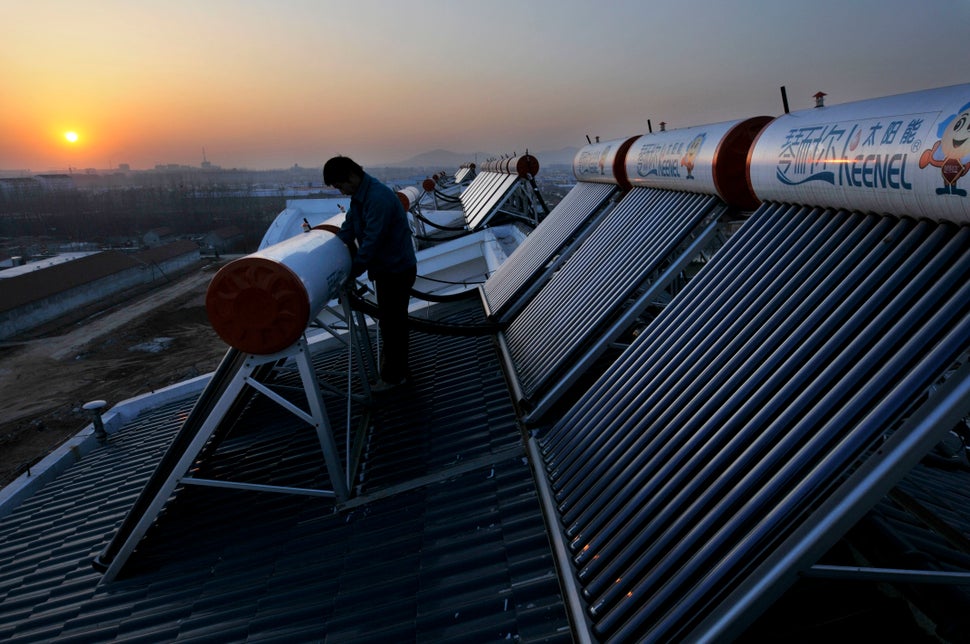 Workers install solar heaters on the roof of a house in Rizhao. Dec. 21, 2009.
Workers install solar heaters on the roof of a house in Rizhao. Dec. 21, 2009.In Fan’s youth, the air was “much better than now.” Yes, Rizhao has always had marine haze, but it was different from the gray-tinged smog of today. Nevertheless, he cracks a window “for pollution” — in other words, so he can smoke. My friend Fan no longer cares to discuss carbon neutral plans, or even climate change, really. Instead, he emphasizes what improvements there have been on his watch in air and water pollution.
That afternoon, Fan comes back with a driver in his special “0 0” government license plate car to give me a VIP tour of the port, the seashore and other points of local interest. The first stop is to show how tall buildings can still employ solar hot-water heaters — by hanging them off their balconies. There are bigger yachts in the marina, and any algal blooms have been tamped down by the crisp fall weather. “Better than Qingdao,” Frank says. A bride wearing a brilliant red wedding dress has her picture taken in front of the glamorous boats.
On the other side of town, a Great (Plastic Netting) Wall has been built around the entire port at great expense to keep iron ore and coal dust from blowing into the city. Water trucks prowl the streets, spraying to keep down any dust that does escape. To cut down even further on dust, trucks carrying dirt have netting on top, something that never happens in other cities, according to Frank. There are even a few trucks powered by liquefied natural gas to decrease the soot from diesel burning, a problem that plagues ports the world over. A giant conveyor belt is being built to move iron ore and coal from the port and eliminate 20,000 truck trips per day, according to Fan.
To get to dinner after the tour, Frank, Fan and I stroll through Silver River Park. The Silver River is the Chinese name for the Milky Way, our home galaxy. The park is really an old quarry transformed into a pond and greens dimly lit by solar lanterns. The real Milky Way is invisible, but I do actually spot a star in the sky, a first for me in urban China. Rizhao is different from the gray-tinged hellscapes of, say, rare-earths rich Baotou and smog-socked Beijing. But why?
So many environmental cleanup efforts have fallen by the wayside in China over the early years of this century.
The edicts of any government are only as good as those following them. Take the war on pollution. Rizhao’s coal-fired power plant has pollution-control technology for two of its four units. Controls for the sulfur dioxide that causes acid rain are slowly being added. The six local kilns that churn out cement have technology that cuts down on the smog-forming nitrogen oxides that would otherwise go up the smokestack. Small boilers are being shut down throughout the province in favor of big, efficient ones like those at the big power plant. Fan describes all this as “very tiring work.”
Even with the controls, however, the question remains whether the technology even gets turned on. That decision has more to do with the powerful power company Huaneng and its relationship with the central government than anything the municipal government might command. Plus, the power plant must provide the city’s heat in winter despite all those solar hot-water heaters.
There is no immediate prospect for Rizhao or even Shandong Province to switch away from burning coal to burning natural gas to make electricity, even if fracking comes to China in Sichuan Province or elsewhere in the west. Imported gas from Russia is simply too expensive.
There is not enough marsh gas to light a city. And then there is the fact that even with such controls at big industrial sources, the burgeoning fleet of cars makes the point moot. So although the amount of pollution from Rizhao’s factories, power plants and port has gone down thanks to Fan and his colleagues’ efforts, the “air quality [is] a little worse,” Fan admits. The “main problem may be vehicles.” Such cars are “impossible for Rizhao to control,” Fan adds, taking another drag on a cigarette.
 A fisherman on stilts nets shrimp in Rizhao. Oct. 13, 2015.
A fisherman on stilts nets shrimp in Rizhao. Oct. 13, 2015.Some of the necessary work in China is simply to imagine a different future, cities built better, happy people, life beyond the daily grind. The Chinese people can certainly make the future they want to see. A key to that will be seeing through illusions.
Rizhao is not actually the first city to get sunshine. Japan has it beat, and by international rules, Apia, the capital of Samoa, is the true first city in the world to get sunlight each day. But perhaps Rizhao can be the first to show how sunshine can be better used in China. Meanwhile, the megacities of Beijing, Guangzhou and Zhenjiang have all pledged to stop growth in CO2 pollution by 2020 — and the country as a whole plans to do the same by 2030.
Shandong Province is now a pilot area for the circular economy at a provincial level. And if old Shandong can become a circular economy, then perhaps so too can China as a whole. The Chinese dream does not have to be a nightmare for the rest of the world. A better Anthropocene might come to be.
Just as one man in Tiananmen held back the tanks with a single act of courage, single acts like the ceaseless work of Fan and his compatriots across the country can stand athwart the juggernaut that is the fossil fuel economy and begin to shift it, ever so slightly at first but then more and more and more, in a new direction.
This is a modified excerpt from “The Unnatural World: The Race to Remake Civilization in Earth’s Newest Age,” by David Biello (Scribner, a division of Simon & Schuster, Inc. 2016).

